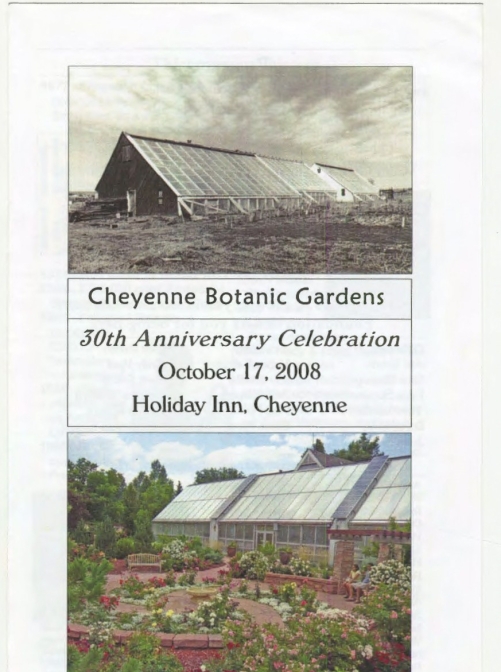As spring moves into summer here in Wyoming, a profusion of little yellow flowers are showing their cheery, if cursed and cussed, faces on the fleetingly green plains and in town lots. But how did the dandelion make it all the way out to Wyoming? While there are most likely several accounts of the scourge’s first appearances, at least two are found in the collection here at the Wyoming State Archives.
In 1883, the Goldsmith family, lately from Iowa, homesteaded the barren plains several miles north of Cheyenne. There, Peter, Eva, and their five children scratched out a living from the virgin prairie. Their daughter, Eva Goldsmith Guy, later told the story of her mother’s careful cultivation of her dandelion patch:
“I remember my mother sending back to Iowa to one of her sisters for dandelion seed. She knew it was a hardy plant and thought perhaps if carefully planted and carefully tended, it might grow, and we could then have greens in the early spring besides the beautiful gold blossoms. They grew just a few at first. We were delighted, and when my sister was married in ’86 and moved forty miles farther north in the blue grass country, my mother very carefully gathered a few of the precious seeds to give them to her so she could have greens. Little did we dream what that innocent looking plant, with the glorious yellow blossoms, would mean in the years to come…” — WPA Bio File 386, “Recollections of 1883” by Eva M. Guy

Many early settlers, especially women, experience an intense culture shock, especially when it came to growing plants on the virgin prairie. Like Eva Goldsmith, these women would carefully tend seeds and seedlings brought with them or sent by family. Here, a ranch wife proudly displays her collection of plants growing in tin cans. It is difficult to tell from this distance, but they may be flowers. (WSA Sub Neg 9196, Bob Fullerton Ranch, Shell Creek, Wyoming, 1890. Cropped to show detail)
Wyoming homesteaders weren’t the only ones looking for a hardy ray of sunshine. Set in Nebraska, the picture book Dandelions by Eve Bunting tells the story of how these resilient little flowers became a metaphor of hardiness and resilience for one lonely homestead housewife and her family on the great plains.
On the other side of Wyoming, in Evanston, the scourge arrived as a stowaway:
Mrs. Jubb, or “Auntie Jubb,” as she was called, also had an eye to floral decorations, though her efforts were not a joy to the residents, as they consisted in the importation of dandelion seeds from England. No doubt this common pest would have reached the country in time even without her agency. She was well known and well thought of, and her services were in demand in many an emergency such as nursing and the management of homes. — Uinta County, It’s Place in History (1924)
 Whatever their origin, dandelions were a common sight in disturbed soil across the state by 1896. That year, a disgusted Dr. Aven Nelson [1] described them in his First Report of the Flora of Wyoming:
Whatever their origin, dandelions were a common sight in disturbed soil across the state by 1896. That year, a disgusted Dr. Aven Nelson [1] described them in his First Report of the Flora of Wyoming:
Taraxacum officinale… Apparently the Dandelion found its ideal home when it reached Laramie. It occupies every foot of ground along the irrigation ditches of our streets and takes complete possession of the lawns where eternal warfare is not waged upon it. In luxuriant growth and blossom from April to November.
During the Great Depression of the 1930s, the Works Progress Administration (WPA) put local writers to work gathering stories, histories, and folklore from around the state. Of course, the dandelion made an appearance here, too. This schoolyard fortune-telling game didn’t look too kindly upon the prospects of the Victors, Xaviers, and Zebulons.
Blow seeds from the dandelion until none remain, counting each puff as a letter of the alphabet; the letter which ends the blowing is the initial of the name of the person the blower will marry. — WPA Subject File 1348, Uinta County Folklore

The cheery dandelion, which thrives in disturbed soil, has been a common sight on playgrounds for many years. (WSA P76-9/98, Children at the Diamond Flats School, Goshen County, 1918-1919)
Used as medicine since at least the Romans, it is no surprise that dandelions also appeared on the list of Mary Elizabeth Simmons Robison’s home remedies:
Cooked dandelion greens, also water-cress, for liver trouble. — WPA Subject File 1348, Uinta County Folklore
- Dr. Aven Nelson was the head Botanist at the University of Wyoming in Laramie and an expert in plants of the Rocky Mountain region.






 Whatever their origin, dandelions were a common sight in disturbed soil across the state by 1896. That year, a disgusted
Whatever their origin, dandelions were a common sight in disturbed soil across the state by 1896. That year, a disgusted 